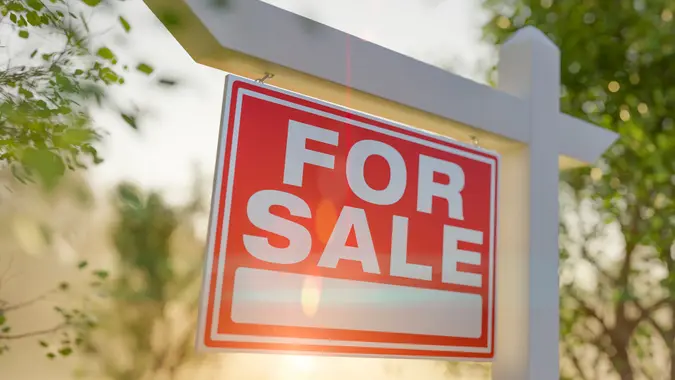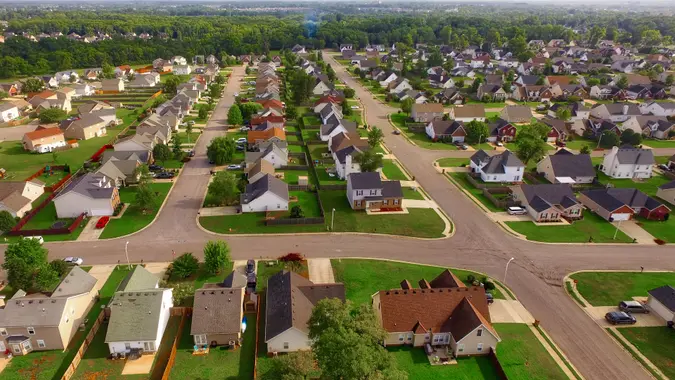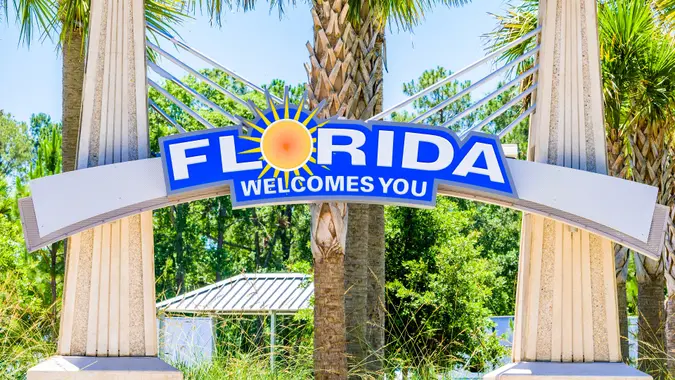10 Cities Where House Renters Are Staying Put Instead of Looking To Buy

Commitment to Our Readers
GOBankingRates' editorial team is committed to bringing you unbiased reviews and information. We use data-driven methodologies to evaluate financial products and services - our reviews and ratings are not influenced by advertisers. You can read more about our editorial guidelines and our products and services review methodology.

20 Years
Helping You Live Richer

Reviewed
by Experts

Trusted by
Millions of Readers
One of the cornerstones of the American dream is to own a home — and for a long time, it was a practical goal. But in the 21st century, skyrocketing home values and high mortgage rates have priced many Americans out of the market and convinced them that the better option is to keep on renting.
A growing number of Americans are choosing to stay in their rental homes for 10 years or more in response to high home prices and tight inventory, according to a new study from Point2Homes, a house rental search platform.
There’s no mystery as to why more renters are staying put. Over the last 20 years, median home sale prices have climbed over 80% — from $228,800 during the fourth quarter of 2004 to $419,200 during the fourth quarter of 2024, according to data from the Federal Reserve Bank of St. Louis. This decade alone, home prices have risen by about 28%.
Rental prices have risen at roughly the same rate over 10 years — from a national average of $1,185 in 2020 to an average of $1,521 in 2024, according to an iProperty Management analysis of U.S. government data. The difference is, when you rent a home, you don’t have to worry about making a down payment that can easily run into the tens of thousands of dollars. And renters who opt for long-term leases can lock in the same rate year after year, even as home and rental prices continue to rise.
Here’s a look at 10 cities where house renters are staying put instead of looking to buy, according to Point2Homes.
Next, find out the cost of renting vs. owning in every state.
Oxnard/Thousand Oaks/Ventura, California
- 2017 share of very long-tenure renters: 17.7%
- 2022 share of very long-tenure renters: 25.4%
- Increase in share: 7.6
New Orleans/Metairie, Louisiana
- 2017 share of very long-tenure renters: 14.5%
- 2022 share of very long-tenure renters: 21.7%
- Increase in share: 7.2
Providence/Warwick, Rhode Island/Massachusetts
- 2017 share of very long-tenure renters: 18.2%
- 2022 share of very long-tenure renters: 23.8%
- Increase in share: 5.6
Buffalo/Cheektowaga/Niagara Falls, New York
- 2017 share of very long-tenure renters: 20.5%
- 2022 share of very long-tenure renters: 26.0%
- Increase in share: 5.5
Riverside/San Bernardino/Ontario, California
- 2017 share of very long-tenure renters: 13.5%
- 2022 share of very long-tenure renters: 18.9%
- Increase in share: 5.5
Bakersfield, California
- 2017 share of very long-tenure renters: 13.7%
- 2022 share of very long-tenure renters: 19.1%
- Increase in share: 5.4
Omaha/Council Bluffs, Nebraska/Iowa
- 2017 share of very long-tenure renters: 12.2%
- 2022 share of very long-tenure renters: 17.5%
- Increase in share: 5.2
Kansas City, Missouri/Kansas
- 2017 share of very long-tenure renters: 11.4%
- 2022 share of very long-tenure renters: 16.3%
- Increase in share: 5.0
Los Angeles/Long Beach/Anaheim, California
- 2017 share of very long-tenure renters: 25.4%
- 2022 share of very long-tenure renters: 30.2%
- Increase in share: 4.8
Sacramento/Roseville/Arden-Arcade, California
- 2017 share of very long-tenure renters: 12.9%
- 2022 share of very long-tenure renters: 17.8%
- Increase in share: 4.8
More From GOBankingRates
 Written by
Written by  Edited by
Edited by 

























